The Saints.
Great siddhas.
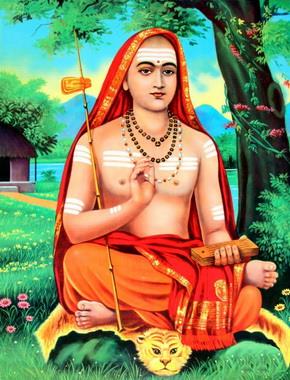
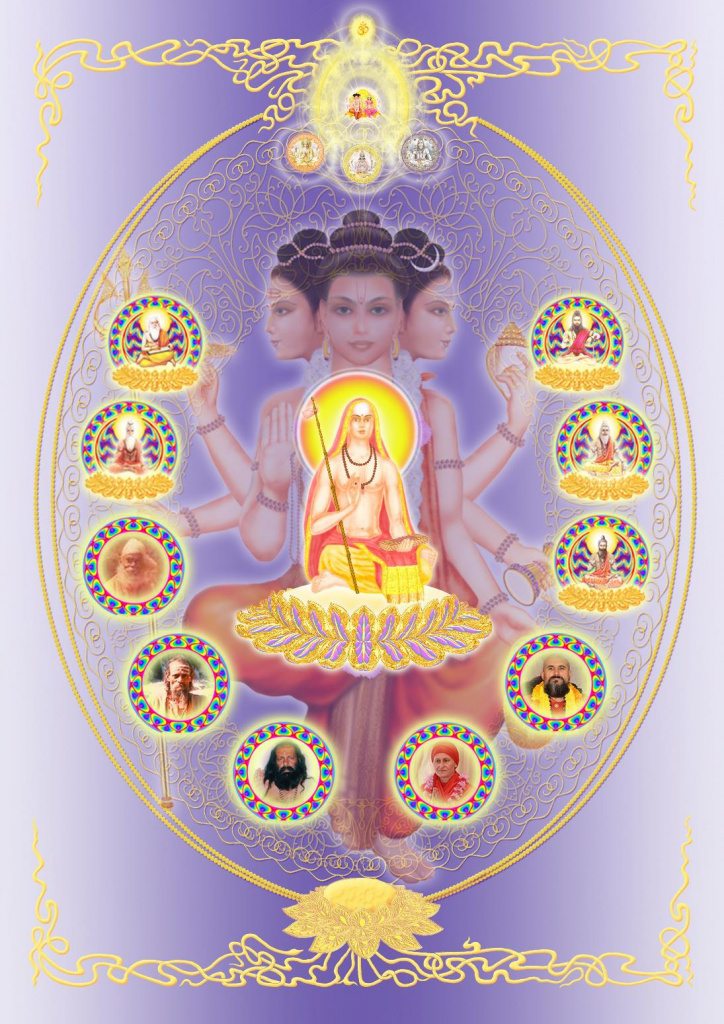
The northern lineage tradition of Advaita Vedanta transmitted by Swami Vishnudevananda Giri
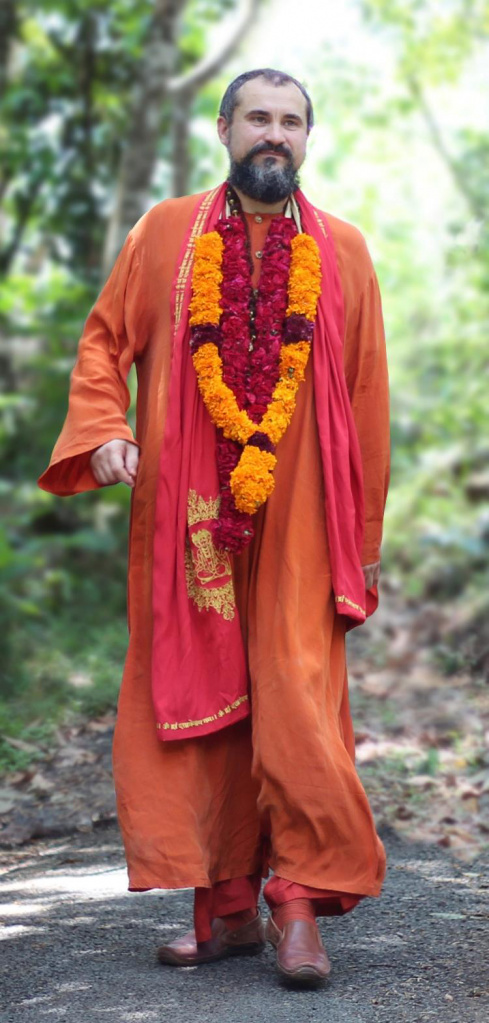
“What is the criterion for the truthfulness and completeness of our transmission line?
First of all, it is the presence of the guru-shishya parampara, the continuous lineage of the Moksha Dharma.
The transmission line is like a channel through which knowledge of Divine is transmitted from the Absolute himself, the Creator God, the great gods, rishis, siddhis, means saints.
We follow two main lines. Northern, Himalayan along the line of Shiva, Dattatreya, the order of Dattatreya - Juna Akhara recreated by Sri Shankara. And southern - along the line of Siddha Pambatti and Guru Shivaprabhakara Siddhayogi Avadhuta Brahmananda from Kerala.
With these lines, their masters, gurus, devotees, there is always a close connection. All this is the guru-shishya-parampara - the "channel" for the transmission of the teachings."
Swami Vishnudevananda Giri
Spiritual tradition and lineage of Advaita Vedanta and Siddha yoga in the transmission of Mahamandaleshwar Sri Guru Swami Vishnudevananda Giri
The traditional lineage in the transmission of Mahamandaleshwar Sri Guru Swami Vishnudevanada Giri includes several lineages, of which the most important are the two main branches, called "guru-shishya-parampara" in Hinduism.
The southern line of transmission (main) is the lineage of the siddhas of southern India and the Guru Shivaprabhakara Siddhayogi Avadhuta Brahmananda.
The first line of succession leads to the South Indian tradition of immortal yogis-siddhas and goes back through Swami Vishnudevananda Giri to the famous yogi-miracle worker Swami Shiva Prabhakara (Guru Avadhuta Brahmananda) from the state of Kerala, famous in southern India. From him, it goes back to the god Ayappa, who is worshiped in the south of India, as well as to his teacher Siddhu Rishi Pambatti.
From Rishi Pambatti it goes back to Rishi Satyamuni, from Satyamuni to Rishi Nandi Devar, from Nandi Devar to Shiva himself. Rishi Nandi Devar achieved svarupa-samadhi in the city of Kashi (Varanasi, Benares). His teacher was Shiva Himself, and the disciples of Nandi Devara are also the rishis Tirumular, Patanjali, Dakshinamurti, Romarishi.
Northern line of succession
The northern line of spiritual succession goes back to the ancient monastic order of Juna Akhara, founded for a thousand years by Sri Shankaracharya and the tradition of ten names (dashanami sannyasa). The main deity of this order is Dattatreya. He is also revered as an emanation of Shiva.
In this tradition and in the order itself, Swami Vishnudevananda was initiated in 2010 by the Mahamandaleshwar of the Indian monastic order Juna Akhara Somnath Giri Maharaj (Pilot Babaji) and his acharya Mahamandaleshwar Swami Avdeshananda Giri. From Pilot Babaji, the line of succession leads to his guru-siddha Hari Baba, who is able to travel freely in space, from him to the enlightened sage Avatar Baba, and then through the line of guru to Sri Shankaracharya himself.
Sri Shankaracharya is considered the founder of the now authoritative and growing monastic order of "ten names", the incarnation of Shiva, an outstanding "architect" of the teachings of Advaita Vedanta and a reformer of Hinduism, who restored authority and cleansed the Vedic philosophy of impurities. For all of us, he is the founding teacher, founder, "Guru-acharya" and occupies an important place in the Tree of Refuge, in our parampara.
From Sri Shankaracharya, the lineage leads to his guru Govindapada, and from him to Gaudapada, the author of the famous philosophical treatise on Advaita, Mandukya Kariki. From Gaudapada she goes to Shukadeva, and from him to Rishi Vyasa himself, the author of the Vedas. Sri Shankaracharya himself also personally received blessings and instructions from Vyasa. From Vyasa, the lineage goes back to Rishi Vasishtha, the son of the Creator, and to the Himalayan sages - the immortal avatar incarnation of the three gods, Avadhuta Dattatreya, Saint Narada and the eternally young Sanatkumar, born from the mind of Brahma. The teachings of Sanatkumara are set forth in the vast collection of the Upanishads and Puranas, as well as in the Agamas and Tantras. In the tree of the Himalayan tradition, Sanatkumara is believed to represent the root, and the rest of the sages represent the trunk and branches of this tree.
Finally, at the top of this ancient line of succession, there are the great gods of Sanatana Dharma - Brahma, Vishnu and Shiva, the legendary and revered throughout the world of Hinduism, the Creator, Keeper and Destroyer of the universe, who are the purest reflection of the Absolute itself, the One Brahman. Brahma the Creator received the Vedas according to one version from Vishnu, according to the other from Shiva, and the latter from the most non-dual Absolute, Parabrahman, described in the Upanishads. This is the northern lineage of the Advaita Vedanta tradition in the transmission of Mahamandaleswar Sri Guru Swami Vishnudevananda Giri.
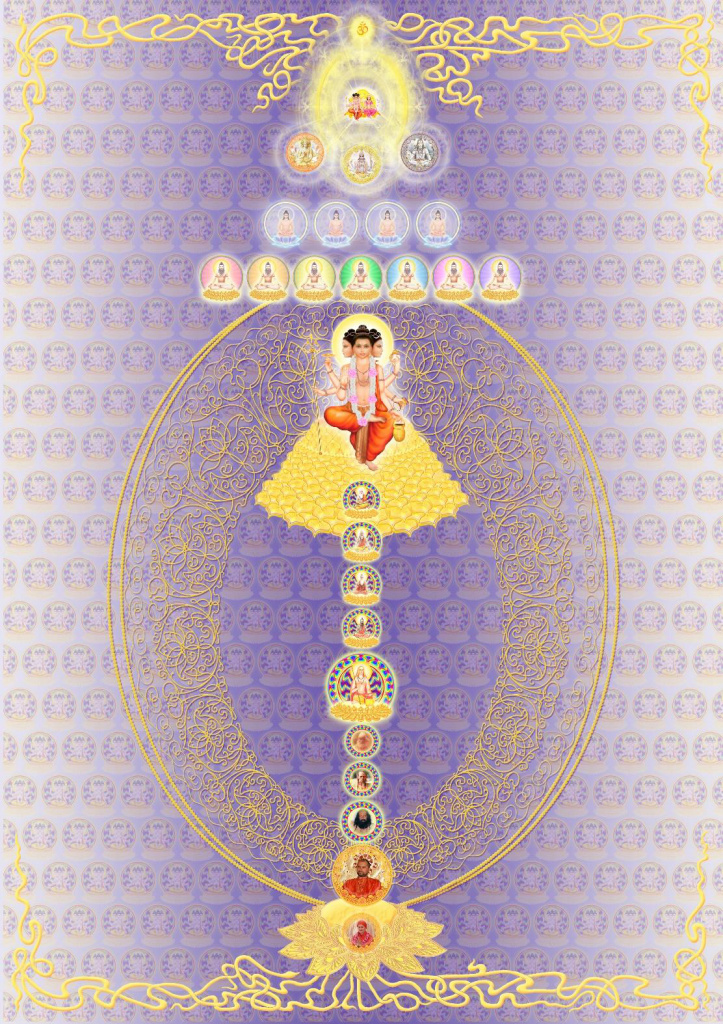
Narayana
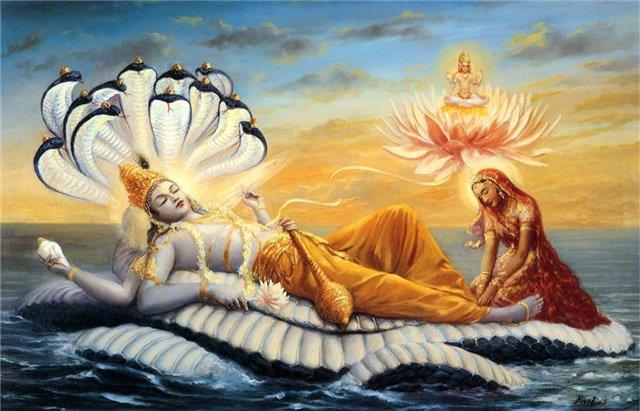
Narayana is the Absolute, the Supreme God in His infinite all-pervading form. The Yajurveda says that Narayana pervades everything that can be seen or heard in this universe from the inside and outside. Another translation of the word Narayana is "sleeping on the waters of the Causal Ocean." In Sanskrit, the word "nara" refers to all creatures (jivas). Thus, another meaning of the name "Narayana" is the shelter for all living entities.
Narayana participates in the creation of the 14 worlds of the Universe as Brahma, when he consciously manifests under the influence of Raja Guna. He maintains and preserves the universe as Vishnu when he manifests through the Sattva guna, and destroys the universe at the end of the maha-kalpa as Shiva or Rudra when he manifests in Tamas guna.
In the Bhagavad Gita, Narayana is described as having the form of a universe (Vishvarupa) that is beyond human perception or imagination. The Bhagavata Purana declares Narayana as Para-Brahman - the Supreme Lord, who creates innumerable universes and resides in each of them as the all-pervading Absolute.

Brahma
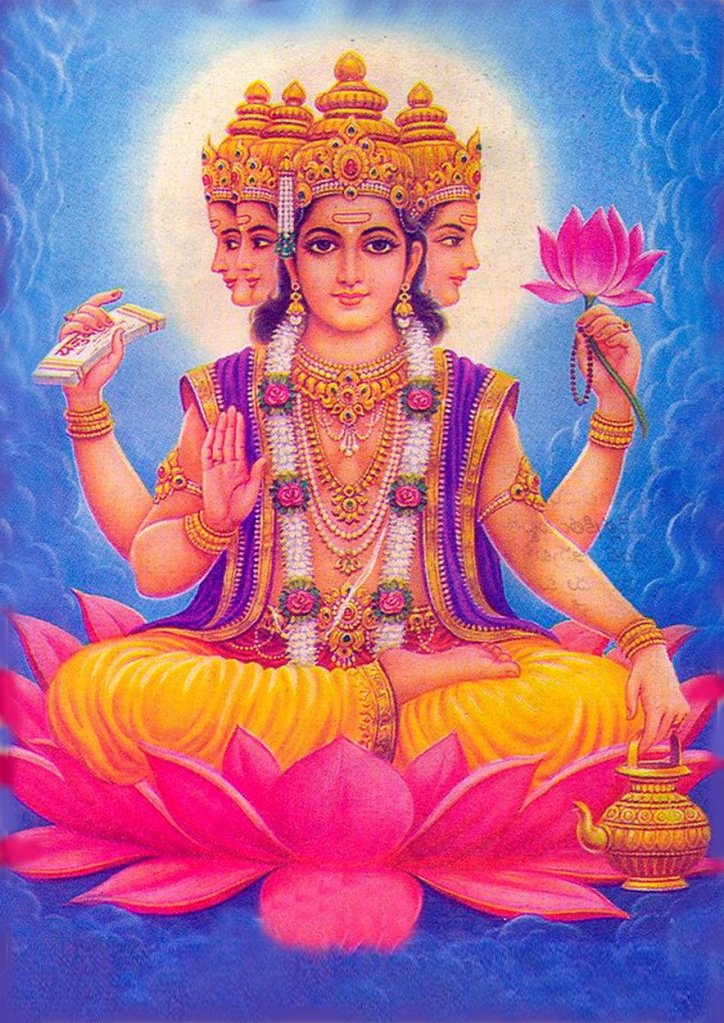
Brahma is the god of creation, along with Vishnu and Shiva is one of the gods of Trimurti. His consort is the goddess of knowledge and learning Sarasvati. Brahma is the creative force, the creator and progenitor of the gods and the universe. He protects the order in the Cosmos and the morality established in society, while Vishnu preserves the Universe, and Shiva destroys it.
According to Shrimad Bhagavatam Brahma is self-born, he appears at the very beginning of the process of creation of the material universe. In the Mahabharata, Brahma is called “revealed and unrevealed, non-existent and existing, that which is the entire universe, which is different from the existing and non-existent; the creator of the highest and the lowest, the ancient and the highest, inexhaustible and benevolent, who himself is benevolence."
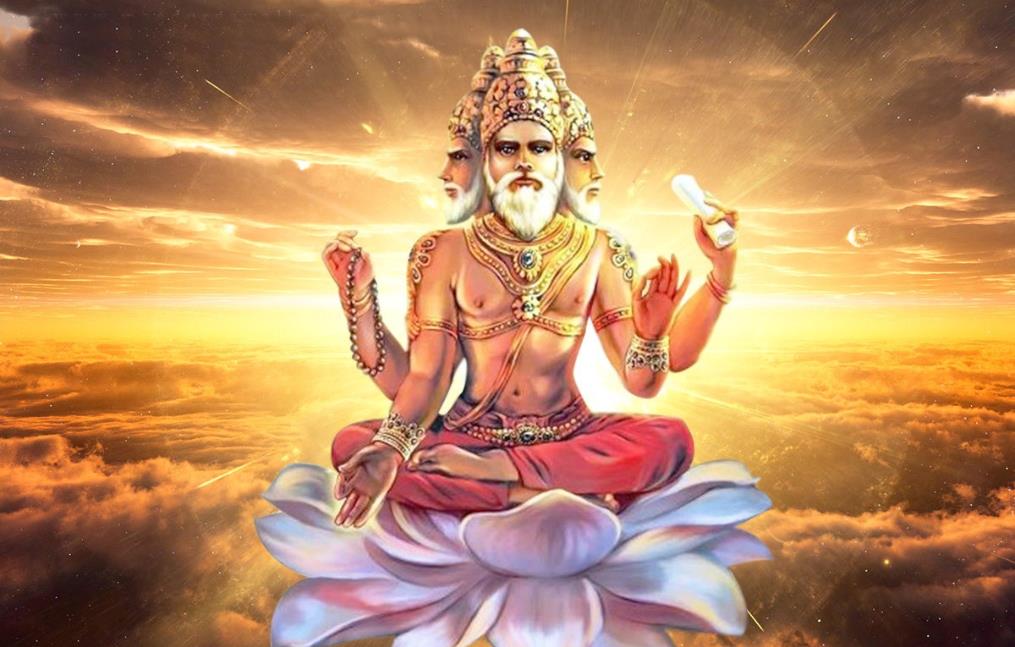
Vasishta
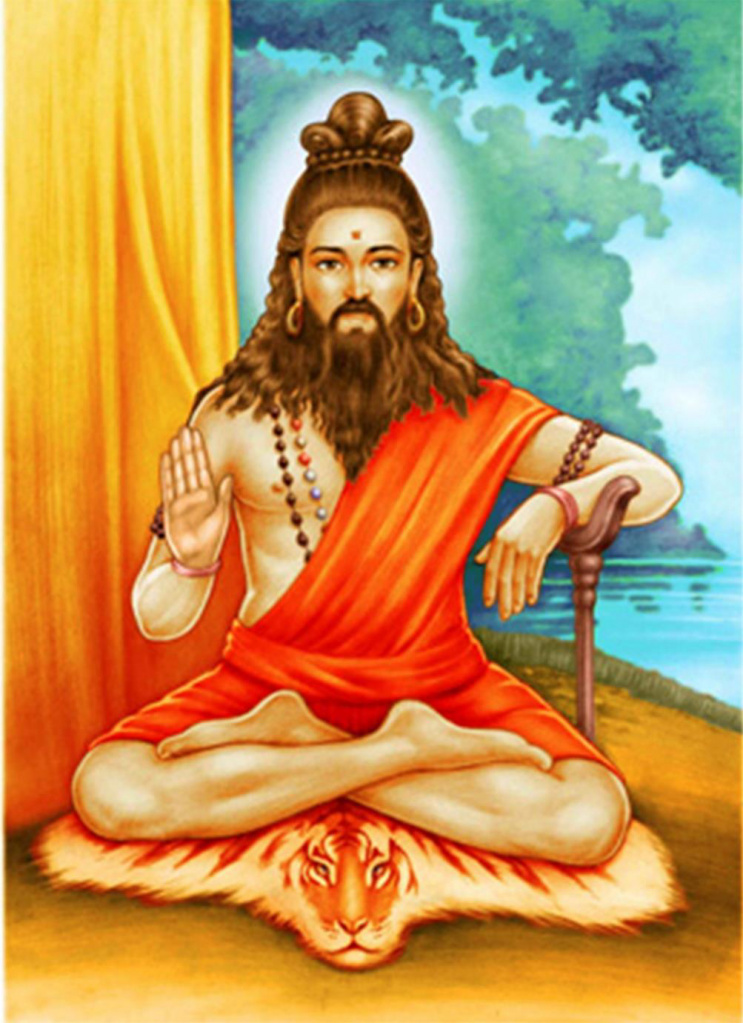
Vasishtha is the immortal son of the creator Brahma himself, one of the great lords and guardians of the universe. Also Vasishtha is one of the seven divine sages, rishis. He is the husband of Arundhati, one of the progenitors of earthly beings. The very word Vasishtha in ancient Indian means "the richest" or "the best."
There were always many disciples in Vasishtha's ashram. The gods gave him the cow Nandini, which, in addition to milk, gave food to its inhabitants, fulfilling their desires. It is described that he always strictly performed his duty and followed the rituals prescribed by the scriptures.
Vasishtha was the family mentor of the rulers of the Solar Dynasty. During the Treta Yuga, he was the guru of Rama and showed him the way to the highest goal of human life - moksha. Vasishtha's instructions, which he gave to Rama, were included in one of the greatest sacred texts - Yoga Vasishtha. The highest levels of knowledge of the sage were set forth in Vasishtha Samhita, which, unfortunately, has not reached our days. Fragments of the lost text can be found in other sources in the form of quotations, but the wisdom that Vasishtha put into this work was preserved intact only in the oral tradition of the Himalayan masters.
Shakti Muni
Shakti Muni or Shakti Maharishi is the eldest son of Rishi Vasishtha and Arundhati, the father of the sage Parasara.
One day, while traveling, Shakti Muni met King Kalmashapada of the Ikshvaku clan. Kalmashapada went hunting, and there, in the dense thickets of the forest, on a narrow path, the hermit Shakti met him. The king ordered the hermit to give way; but the sage did not leave the path, and then Kalmashapada, blinded by pride and anger, struck the brahmana with a whip.
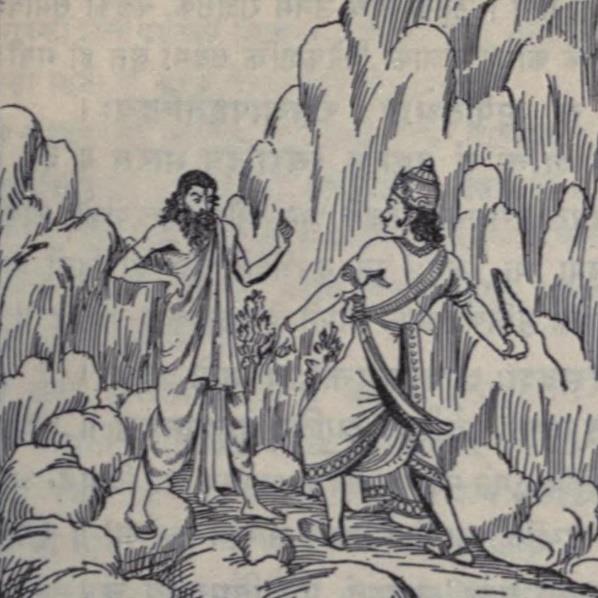
Shakti cursed the unreasonable king: “You treat a pious hermit like a Rakshas! So let from now on you become like Rakshasas to eat human flesh! O most despicable of kings, be you a cannibal!"
Kalmashapada, frightened by a terrible curse, began to beg the son of Vasistha for forgiveness. But at that time the great ascetic Vishvamitra came to the country where Kalmashapada ruled. He came to the kingdom of Ayodhya with the secret intention of taking the place of the supreme priest of the rulers of the Ikshvaku clan, ousting his rival Vasishtha. When Vishvamitra learned about the curse of Shakti, he sent an evil Rakshas to King Kalmashapada, and he possessed his body. Thus, due to the deceit of Vishvamitra, the curse of Shakti was fulfilled, and the unfortunate Kalmashapada, possessed by Rakshas, forgot about his human nature.
The next time Kalmashapada met the brahman Shakti, the eldest son of Vasishtha, he told him: "Since you have put this terrible curse on me, I will start cannibalizing from you!" He pounced on Shakti, killed him and ate him like a tiger devours a deer. And, incited by Vishvamitra, he then devoured all the sons of Vasishtha one by one.
The son of Shakti Parashara was then still a child and Vasishtha took care of his upbringing. It is said that the angry Parashara, wishing to avenge the death of his father, made a sacrifice in order to destroy all the Rakshasas on earth. As a result, many Rakshasas died, but before the yajna came to an end, she was stopped by Shakti's father Vasishtha. He pacified Parashara, urging him not to be angry with the Rakshasas, since the death of Shakti was not their fault, but was predetermined by fate.
Parashara
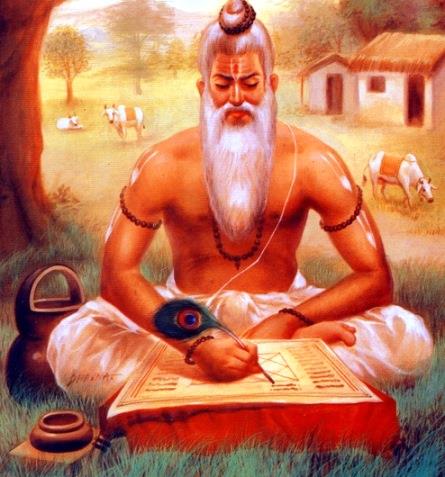
The sage Parashara is the son of Shakti Muni and the grandson of Rishi Vasishtha. Born into a family of great sages, Parashara himself became one of them. In order to gain spiritual power and wisdom, he performed severe austerities. Parashara was raised by his grandfather Vasishtha, as Parashara's father Shakti Muni died before he was born.
It is said that Vasishtha, grief-stricken by the death of all his 100 sons, repeatedly tried to give up his life, until one day, approaching the house, he heard a voice like the voice of his eldest son Shakti recite the Vedas. The sage hurried to his monastery, but did not see anyone there except Adrishyanti, the widowed wife of his eldest son. When asked who read the Vedas in the voice of Shakti, Adrishyanti replied that it was the grandson of Vasishtha, whom she carries in her womb. He has not yet been born, but he already knows all the sacred books by heart. Vasishtha rejoiced in his heart and exclaimed: "My family will not end!" Then melancholy let go of him, and he turned away from thoughts of death.
Adrishyanti gave birth to a son, who was named Parasрara, which means "Savior", for he saved his grandfather Vasishtha from death even before he was born himself. He became a great sage and possessed great power, which he acquired through the knowledge of sacred spells and severe asceticism. He vowed to take revenge on the Rakshasas for the death of his father and made a great sacrifice for the destruction of the very kind of Rakshasas in all three worlds.
The sage Parasрara wrote and compiled many texts, especially those devoted to astrology. In fact, it was he who first laid out the principles of astrological science. His astrological text Brihat Parashara Hora Shastra remains by far the most important text on Vedic astrology.
Vyasadeva

Vyasadeva is a sage who is considered the author or compiler of many ancient and most significant sacred texts - the Vedas, Puranas, the Vedanta philosophical system, as well as the famous epic "Mahabharata". Vyasa is considered the author of the Vedanta Sutras, which, along with the Bhagavad Gita and the main Upanishads, are included in the threefold canon.
According to legend, Vedavyasa was the illegitimate son of the sage Parashara and Satyavati. By virtue of his origin, he received the name Kanina ("illegitimate"), by the color of his skin - Krishna ("black"), and by the place of birth and upbringing - Dvaipayana ("born on the island"). After the birth of Vyasa, Satyavati married King Shantana and gave birth to two sons from him. The eldest of them was killed in battle, and the youngest died childless. Vyasa, who led an ascetic life in the forest, according to the laws of the country and at the insistence of his mother, took two childless widows of his younger brother to him. From them he had two sons: Dhritarashtra and Pandu, the founders of two clans that were at war in the Mahabharata - the Kauravas and the Pandavas.
Sri Vyasa received Vedic knowledge from his Guru, Sri Narada Muni. At the beginning of Kali-yuga, a need arose for the written transmission of knowledge, because as a result of spiritual decline, people began to lose the ability to remember forever what they had heard, and Sri Vyasadev systematized and wrote down Vedic knowledge, dividing it into four Vedas. In this Vedavyasa was assisted by Shri Ganesha, who managed to write with his own tusk under his dictation, without missing a word.
Shukadeva
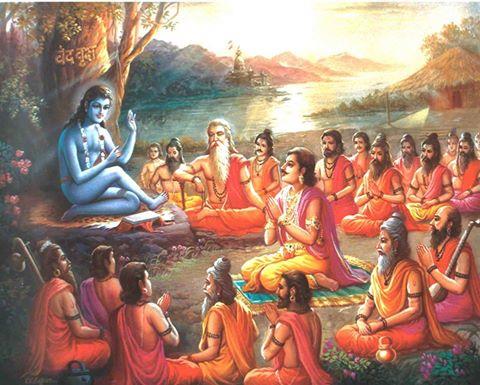
Shuka is the son of Vyasa, he was a liberated soul even before he was born. Vyasadeva told the son the Bhagavata Purana even before his birth, and when he was born, the child began to study this great work and was able to comprehend its meaning. The Puranas also say that Shukadeva surpassed his father in spiritual development, which is clearly shown by the case when Vyasa and Shukadeva, following a forest path, stumbled upon a group of naked girls bathing in a pond. Shukadeva was so pure and free from lust that at the sight of his girls they did not even try to cover their nakedness, but when Vyasa appeared, they immediately hid. This is despite the fact that Shukadeva was a young man and walked completely naked, being transcendental to social norms and regulations, and Vyasa was a very old man. Subsequently, Shukadeva left his father's house to take sannyasa.
Having left his parental home, Shuka wandered under the guise of a mad wanderer, unrecognizable by ordinary people; he was recognized only when he began to recite the Srimad-Bhagavatam. Like other great rishis and munis of those times, Shukadeva lived on milk alone. He did not stay in people's homes for more than five minutes, the time it took to milk a cow and give some milk to a beggar wanderer.
Shukadeva fully narrated the Bhagavata Purana to Parikshit Maharaja when the emperor, hearing of his impending death, went to the bank of the Ganges. Shukadeva, who was traveling on earth at that time and who was only sixteen years old, appeared at the Ganges at the very moment when Parikshit was there, preparing for death and surrounded by saints and great sages. Seeing Shukadeva, Emperor Parikshit bowed to him and inquired, “You are the spiritual master of great saints and devotees. Therefore, I beg you: show the path that can lead to perfection of everyone, and especially those who are on the verge of death. " For seven days, until the very death of Parikshit, Shukadeva answered this and many other questions from the emperor. The questions of Parikshit and the answers to them by Shukadeva constitute the content of the Bhagavata Purana.
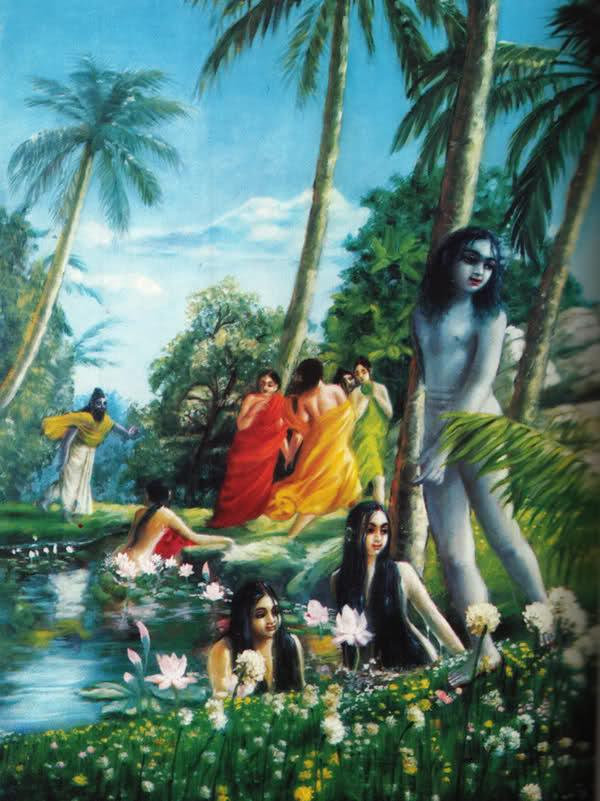
Gaudapada

Gaudapada, an ancient Indian thinker, probably lived at the turn of the 7th-8th centuries. Gaudapada began his activity with a long ascetic practice in the Himalayas and there, having appeased Nara-Narayana (Vishnu) in Badarikashrama, he received permission from him to spread the teachings of Advaita-Vedanta, which was transmitted to him by the legendary sage Shuka. The works of Gaudapada contain the first systematic presentation and interpretation of Advaita Vedanta, they had a huge impact on Shankara and Advaita in general.
In the commentaries to the Mandukya Upanishad - Mandukya Karika, Gaudapada analyzes the most important themes of Advaita Vedanta: the identity of Brahman and Atman, Maya, wisdom ("jnana") as a means of liberation, the incomprehensibility of the Absolute, etc. The philosophy of Gaudapada himself was influenced a lot by Buddhism, in whose period of great spread, undoubtedly, there lived an Indian sage.
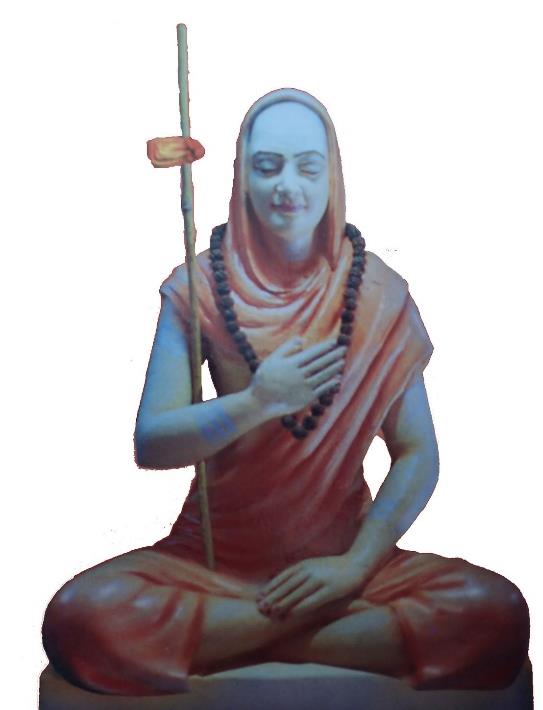
Govinda Bhagavatpada (Govindapada)
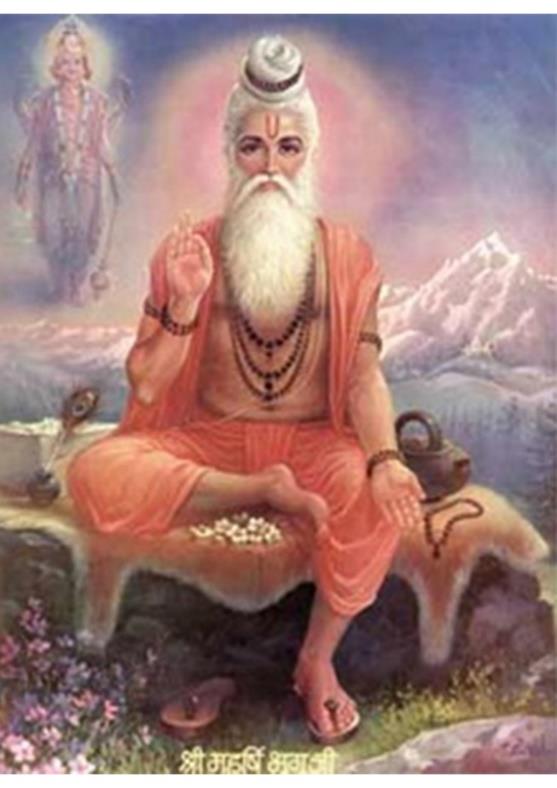
Govinda Bhagavatpada is an Indian thinker, teacher of Advaita Vedanta, spiritual master and saintly sage of the 7th-8th centuries. He is best known for being the guru of the Indian philosopher, founder of Advaita Sri Adi Shankaracharya.
Chandra Sharma was born into a Brahmin family in northern India in Kashmir. Wanting to hear the teachings from Patanjali, he went to the south of India. On the way, he met Gaudapada, who passed on the teachings to him in 9 days. Later he took sannyasa, and after becoming a disciple of Gaudapada he received nama-diksha - Govinda Bhagavatpada. It is said that later Vyasa himself came to Govindapada and asked him to go to the banks of the Narmada River and await the arrival of Shankaracharya, who is none other than Shiva himself, who incarnated for the purpose of writing a commentary on the Brahma Sutras.
As the story goes, Shankara walked hundreds of kilometers through forests, valleys, crossing mountains and rivers, until he finally reached Omkareshvara, where Govinda Bhagavatpada was located under a banyan tree on the banks of the Narmada River in a state of Nirvikalpa-samadhi. Govinda Bhagavatpada accepted Shankara as his disciple and imparted the Teachings of Advaita to him. In turn, Shankara wrote commentaries on all three texts of the Triple Canon, as well as other scriptures, bringing them to a single philosophy of nonduality, thanks to which the Teaching of Advaita gained even greater strength and authority among all Vedic schools.
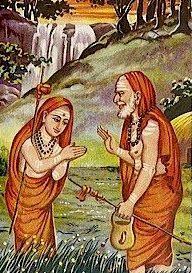
Shankara
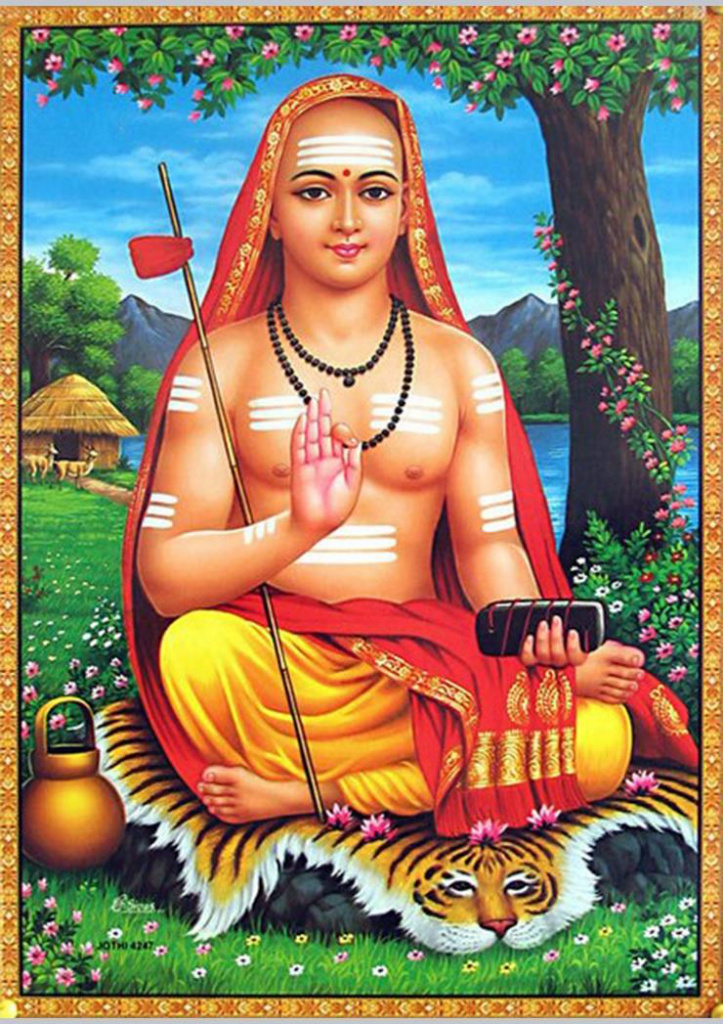
Adi Shankara is the embodiment of Shiva, the great reformer of the Advaita Teachings. He played a huge role in the renewal of the spiritual environment of India, trying to bring dozens of the most diverse, often contradictory philosophical directions to a common basis, and at the same time not destroy them, but direct them to a single goal - non-dual Truth. All activities and works of Shankara had a single goal - to restore the lost authority of the Vedas, to return humanity to the path of Truth.
His father died when Shankara was 5 years old. At this age, he began to study the four Vedas, showing amazing ability, and soon surpassed his teachers in learning. At the age of 8, in front of his mother, a crocodile grabbed him in the river and did not let him go until the woman agreed that her son should become a sannyasi. Shankara went in search of a guru to northern India, where on the banks of the Narmada River he met Govindapada, a disciple of Gaudapada. Here Shankara comprehended the basics of Advaita, wrote most of the Shaiva and Vishnu hymns, created a number of philosophical treatises and a commentary on the Brihadaranyaka Upanishad. Later, Shankara, having received the blessing of his teacher, in four years wrote commentaries on all the works of the "threefold canon": "Brahma-sutras", "Bhagavad-gita" and the main Upanishads.
Also Shankaracharya was a disciple of Sri Gguru Datta, since Dattatreya is the immortal original Teacher of all the saints who are born on earth. Shankara was a devoted devotee of Bhagavan Dattatreya. He is credited with the authorship of various hymns praising Dattatreya, such as "Dattatreya bhujamga stotra." There are two interesting stories about the mystical connection between Sri Shankaracharya and Avadhuta Dattatreya. The first story says that at one time Shankara asked Sri Dattatreya that the sannyasi order founded by Shankara would be well received by society. Dattatreya happily fulfilled his wish by giving his blessing.
Another story describes how Shankara is blessed at the ashram of Dattatreya. The Guru-vamsha-kavya, a kind of verse chronicle of Shankara's life, written by the saint Jagat Guru Sringeri Sachchidananda Bharati, recounts how at the end of his life Shankara traveled from Siddheshwari in Nepal to the ashram of Dattatreya in Mahura. There he placed his stick and it turned into a tree. He put down his offering bowl and it became a sacred tirtha. From then on he remained in the company of the immortal Dattatreya, constantly talking about Vedanta. Before Shankara disappeared from the world, Dattatreya appeared before him in Badrinath. The immortal yogi took him with him to the cave, from where they no longer left.
Sri Adi Shankaracharya is a multifaceted genius who embodied the rare qualities of a philosopher, poet, commentator, orator, saint and religious reformer. It is believed that it was he who revealed the essence of the Vedas and Upanishads. He combined all the opposing concepts, showing that there is only one boundless Reality. Shankara combined three paths of ascent to Truth: the Path of Action (Karma Yoga), the Path of Love and Devotion to God (Bhakti Yoga) and the Path of Knowledge (Jnana Yoga), finding each path a necessary and necessary place in a single method of attaining from the bonds of samsara.
He owns outstanding philosophical and theological treatises that have become the generally recognized "classics" of Advaita Vedanta and Hinduism - "Viveka-chudamani", "Atma-boddha", "Tattva-bodha", "Brahmana Chintanam", "Vakya Vrittih", "Aparoksha-anubhuti "," Shivananda-lahari "," Sundarya-lahari "and many others. In them, Shankara calls everyone to turn to their radiant and immortal nature. He believes that the differences between soul and God are caused by ignorance. He owns the famous saying: “Brahman is Real - the world is not real. The soul is identical with Brahman. " Thus, he expressed the essence of his teaching, which he learned from the Vedas and Upanishads.
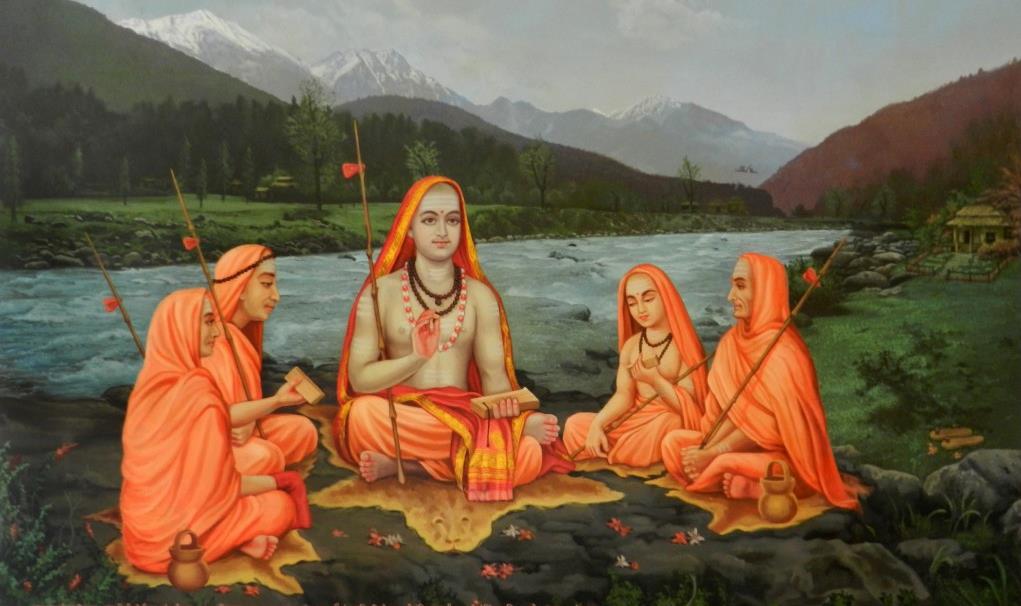
Avatar Baba

Pilot Babaji describes his Guru Avatar Baba as follows in his book The Himalayas Speak:
“Four days later Avatar Baba came. He had an amazing appearance: seven feet tall, sturdy, he wore a turban and had an all-pervading look. He was the teacher of Hari Baba. Someone called him Ramupir, someone called Avatar Giri, and someone called Aughar Baba. It was impossible to understand who he was by birth - a Hindu or a Muslim. He did everything easily and naturally. He spoke almost every language in the world. He knew everything: from prices in the markets to politics. He did not look back at the past, he lived in the present, adding the future to it, and always smiled."
...
“Soon I saw a motionless shadow sitting by the cliff. It was from there that the light came. It was Avatar Baba. When I approached, I saw that an amazing radiance emanated from a body as thin as a skeleton, which illuminated everything around. Finally Baba opened his eyes. They were eyes, as deep as the sea, they sparkled like burning coals. He began to speak, and in his voice one could hear love and tenderness, akin to the feeling that a mother has for her child."
...
“Avatar Baba was very fond of laughing. He could sit down among ordinary people and start smoking his pipe. He made people laugh with his conversations."
From the book dedicated to Pilot Babaji, written by his student Sati Mata ("The Little Prince and the Great Saint", Sati Mata, 2018):
"At one time in the Himalayas, Pilot Baba lived with the teacher of Hari Baba, whose name was Avatar Baba." This hermit was outwardly much older than his pupil. Tall, gray-haired, short-haired, with a well-groomed beard, always in clean clothes, he looked like an intelligent and intellectually educated person. In spiritual circles he was called "the expert of the Vedas" and the rishis - the holy sage. To complete the image, only glasses in a round frame were lacking, framing his clear and complete knowledge of God and the true nature of man's eye. Having a high level of intelligence and awareness, having reached the highest degree of samadhi, he was humble and loved to chat with ordinary people, causing them a state of joy and laughter. There were rumors in the Himalayas that his closest disciple, Hari Baba, was actually 700 years old ..."
Hari Baba

An excerpt from Pilot Baba's book "The Himalayas Speak", where he writes about his first Guru - Hari Baba, who led him through life, and thanks to whom he left worldly life, took sannyasa and devoted himself to the spiritual path:
“Soon we came to the place where an amazing-looking hermit stood. He had earrings in his ears, a bag over his shoulders. A golden glow emanated from his face, and his hair was strewn over his shoulders, and a golden light emanated from them too. At his waist he had a rope woven from black threads."
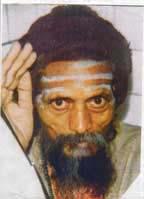
From the biographical book "The Little Prince and the Great Saint":
“Hari Baba was fragile, no more than 45-50 kg in weight, a small hermit in orange robes, with a tousled beard and hair. It seemed that he was not walking, but hovering on the ground."
“Out of his clothes, he was wearing a pink short dhoti, or a piece of cloth tied on his hips ... The ascetic's shoulders were slightly raised up, the ribs protruded forward, several threads of Rudraksha beads and some stones hung around his neck. A light emanated from it, which even seemed to have a pleasant scent. This scent covered Advaita Kapila headlong, and he plunged into a slight ecstasy. The history of Hari Baba goes deep into the past, and there are few people on earth who are able to paint his life story in bright colors. Outwardly, an inconspicuous little man, he belonged to a family of great Siddha Yogis, whose chain of acceptance led to the lotus feet of God Shiva himself, from him to Narayana Baba and other enlightened masters, the last of whom were Avatar Baba, Hari Baba and subsequently Pilot Baba".
“There were days when Hari Baba told something about ascetics and the rules established for them in the Himalayas: - The task of those who renounced the world is to "absorb" the senses inside, isolating their minds from desires and temptations ..."

Pilot Babaji (Somnath Giri)
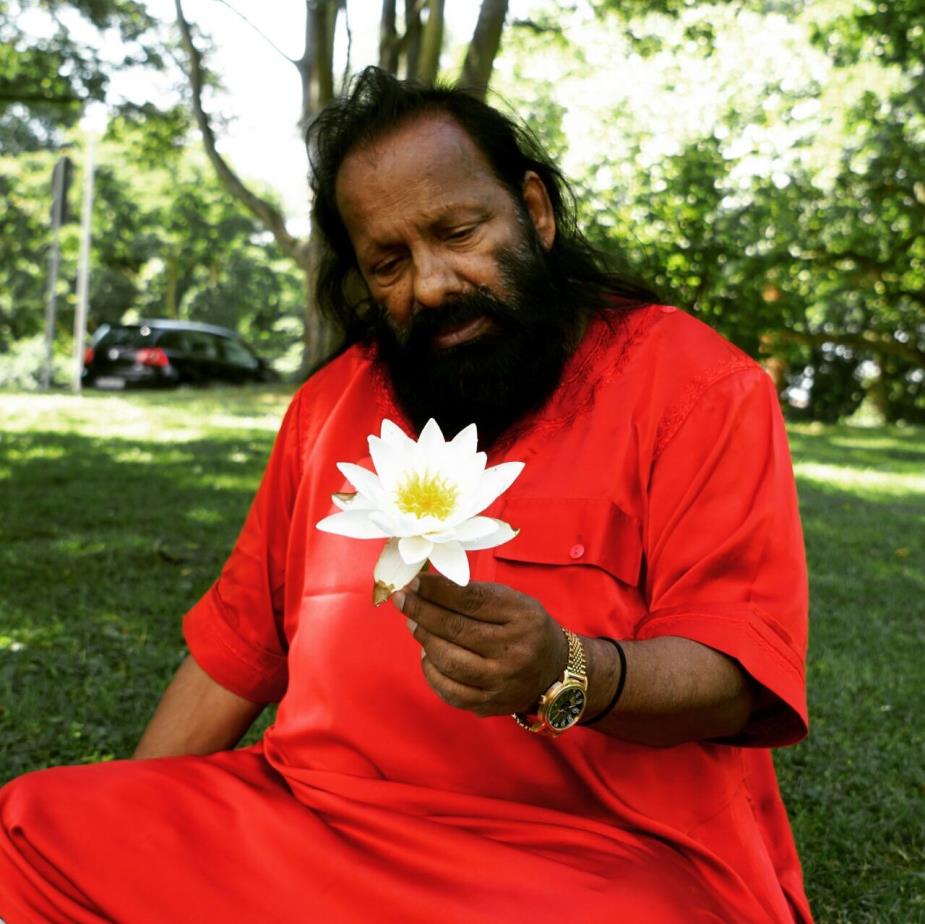
Swami Somnath Giri, popularly referred to with love as Pilot Babaji, is a world famous saint yogi-siddh, famous for his demonstration of long samadhi under water and underground.
Mahayogi Pilot Baba, who received the name Kapil Advait at birth, was born on July 15, 1936 in the eastern state of India - Bihar, where many saints such as Buddha and others lived. In his youth, he served in the Indian Air Force. Known as the "Emerald Pilot," he knew all kinds of warplanes. Taking part in the war with Pakistan in 1962, 1965 and 1971 he received the highest state awards.
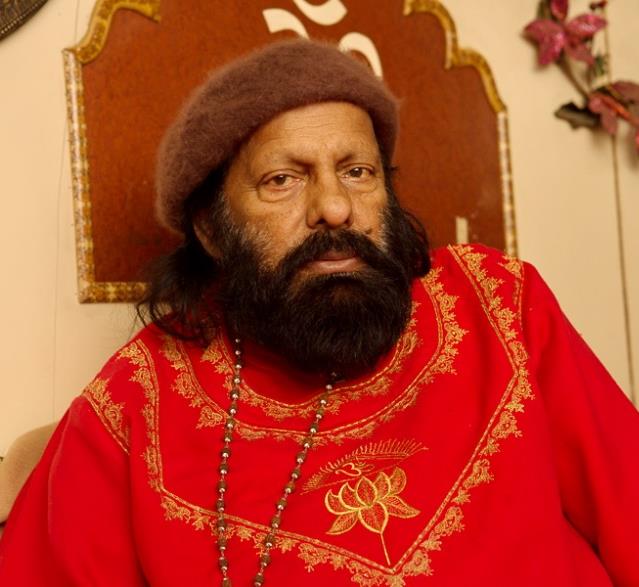
When Babaji was 33 years old, his established life as a fighter pilot changed dramatically under the influence of Hari Baba, who led him through life from childhood. Then he left his military career and went to the Himalayas. At that time he received the name Somnath Giriji from his guru Hari Baba, although throughout India he is much better known as Pilot Baba. For 12 years spent in the Himalayas, he traveled a lot and meditated in caves, lived in Kailash, Badrinath and other holy places in India, performing austerities and repeatedly demonstrating miracles. He met and received initiations from many great saints of the past - Dattatreya, Gorokhontah, Sundarnath, Ashwatthama, and other eminent souls.
Having developed many higher abilities and comprehending his true Self, Pilot Baba devoted himself to spreading the teachings of yoga as a way of knowing the Truth, including allowing scientists to comprehensively explore the psychophysiological processes in his body during meditations, many times performing 21-day samadhi in a hermetically closed (in in some cases completely filled with water) an aquarium in a place visited 24 hours a day by people, etc.

In recent years, Babaji has been carrying out the mission "For World Peace". As part of this movement, he has repeatedly held public demonstrations of underground and underwater samadhi in India and beyond.
Pilot Baba actively attends Kumbha Mela - the largest religious festivals of Hinduism. His ashrams and camps on Kumbha Mela are always full of followers, disciples and devoted admirers from both India and all over the world.
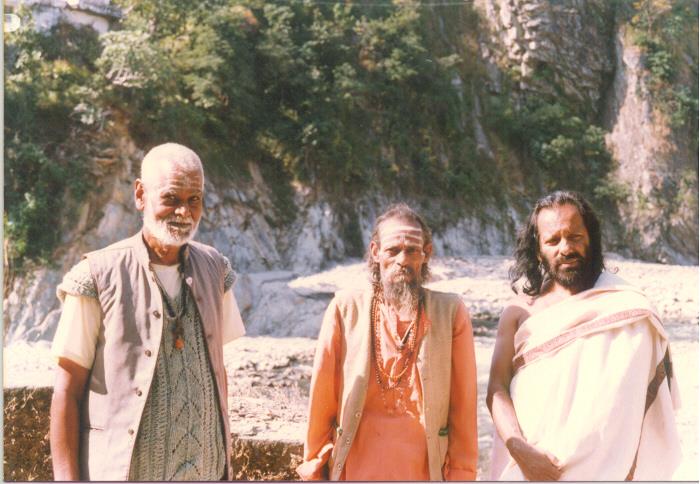
Swami Vishnudevananda Giri

Swami Vishnudevananda Giri - spiritual teacher (authorized to initiate into sannyasa) in the Advaita Vedanta and yoga traditions, sadhu, realized master jnani in the Advaita Vedanta lineage, philosopher, theologian, writer, pilgrim-traveler, having disciples of monks and laymen throughout to the world - in Russia, Ukraine, Belarus, Europe, USA, India, Nepal.
He was born in 1967 in the USSR, on the territory of Ukraine. Spiritual practice, meditation began to practice independently at the age of six, relying on the intuitive memory of the past. Took Sanatana Dharma as his path and worship at 19 years old.
Swami spent several secluded retreats doing yoga tapasya, one of which lasted nearly three years. As a result of the last retreat in 1993-1995, he realized samadhi and attained enlightenment. Sanatana Dharma, the teachings of Advaita Vedanta, Anuttara Tantra has been preaching since 1995.
Swami Vishnudevananda Giri is the author of over 50 books and several hundred articles on yoga philosophy. He gave several thousand lectures on the philosophy of Vedanta, yoga, tantra, metaphysics and mythology of Sanatan Dharma. Teaches jnana, raja, bhakti, karma yoga, kundalini, laya yoga, the teachings of the anuttara tantra of the siddhas.
Initiator of several Advaita Vedanta International Congresses in Russia, several festivals of Vedic culture, Vedic cinema, Vedic literature and interfaith international meetings in Europe within the framework of the "Era of Unity" project.

He is the inspirer of the creation of yoga ashrams in different countries: Russia, Ukraine, Nepal, India, and the spiritual teacher of sannyasis, karma sannyasis and brahmachari.
In 2010, at the world festival of Kumbha Mela in Haridwar, he accepted the status of a sannyasi and a spiritual name from the Mahamandaleshwar of the Order of Juna Akhara Somnath Giri Maharaj (saint Mahayogi Pilot Babaji) and the status of a mahamandaleshwar from the acarya Shandeeshwara of the Juna Akhara Jahari Swami Orracharya Shandeeswara, Sri Swami ... After accepting the status, his full name became - Shrotriya Brahmanishtha Anant Shri Vibhushit Panch Dashanam Juna Akhara Mahamandaleshwar Swami Vishnudevananda Giri, which means “world famous, established in Brahman, possessing unlimited powers, the Lord of the Universal Mandala, the one who attains bliss through Vishnu, the very peak beyond all limits."
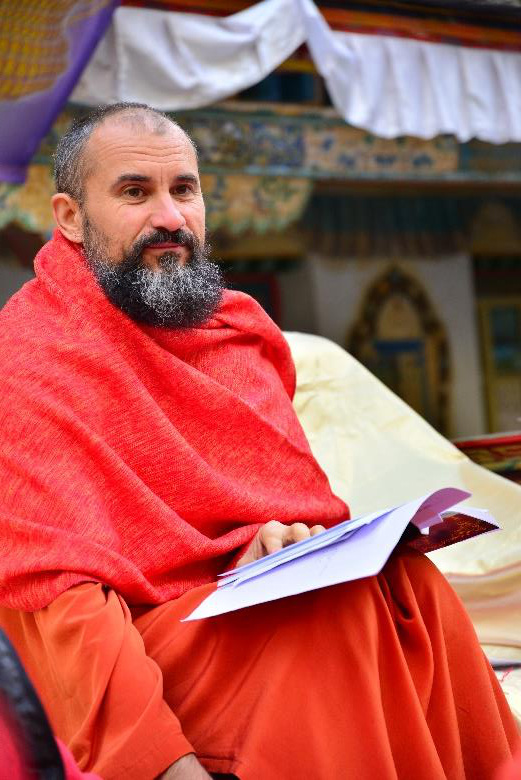
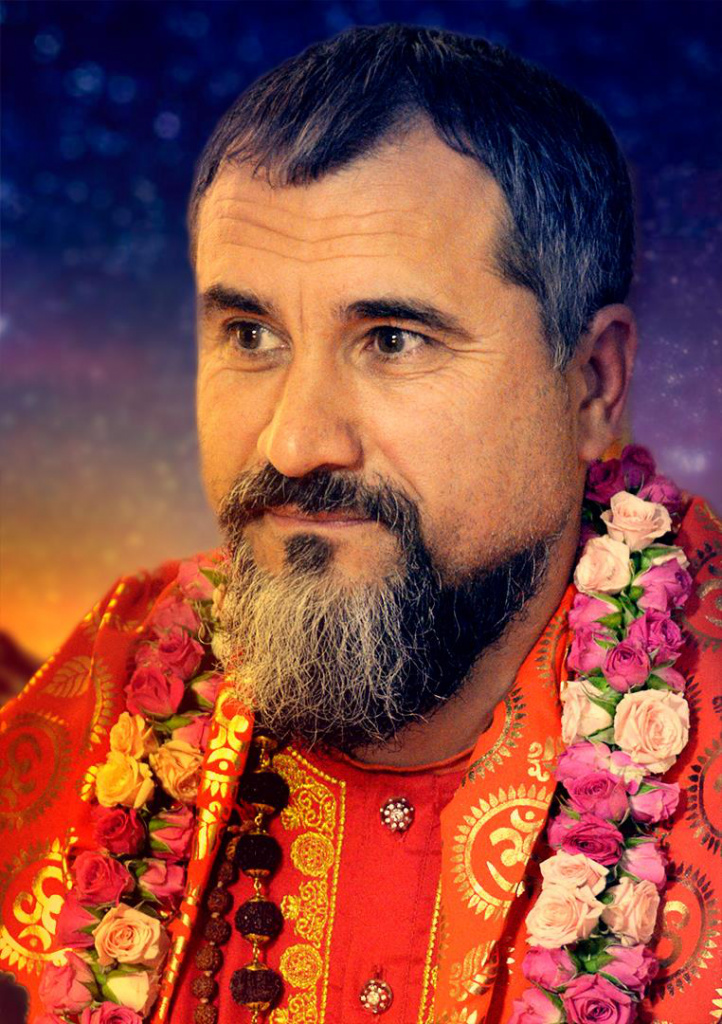
Swami Vishnudevananda Giri preaches Sanatana Dharma, the path of practical Vedanta, the teaching of anuttara-tantra in Russia, European countries, USA, India, Nepal, Indonesia. According to the BBC, he is one of the three most influential Hindu sannyasis among Europeans.
Swamini Ananda Lila Giri
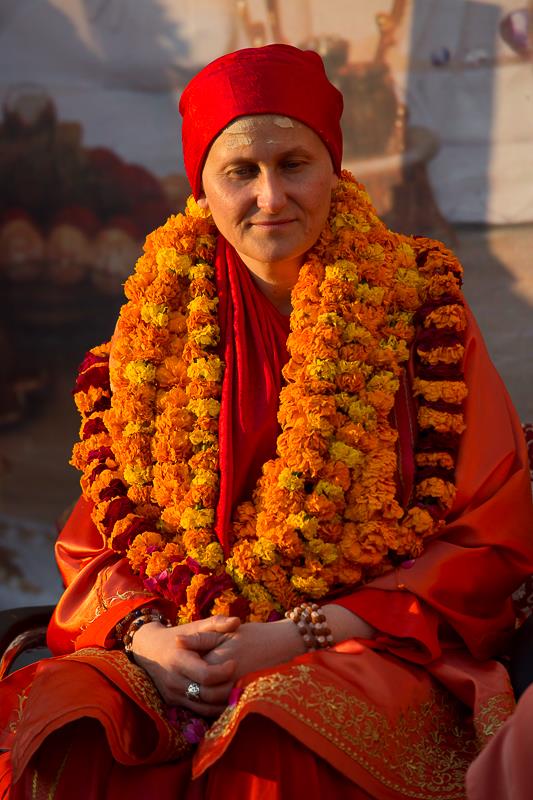
Swamini Ananda Lila Giri - Mahamandaleshwar of the Order of Juna Akhara, abbess of the Ashram of Practical Advaita. Ananda Leela started her yoga practice in 1991, in 1999 she became a disciple of the enlightened yoga master Swami Vishnudevananda Giri in the Advaita Vedanta tradition. Between 2001 and 2009, Ananda Leela served as an ashram manager in Russia. In over 25 years of spiritual practice, she has completed over 20 retreats, including one annual retreat in 2007 and several lengthy dark retreats.
In 2010, at the Kumbha Mela festival in Haridwar, Ananda Leela took purna sannyasa and was ordained to the monastic order of Juna Akhara. In 2013, at the Kumbh Mela in Allahabad, she was initiated into the status of a mahamandaleshwar of the Juna Akhara order with the namo-diksha Sri Sri 1008 Sri Paribrajakaya Acharya Swamini Ananda Leela Giri Ji. She is the first European woman to receive the high spiritual status of "mahamandaleshwar".

Mahamandaleshwara Juna Akhara
Acharya Swami Avdeshananda Giri
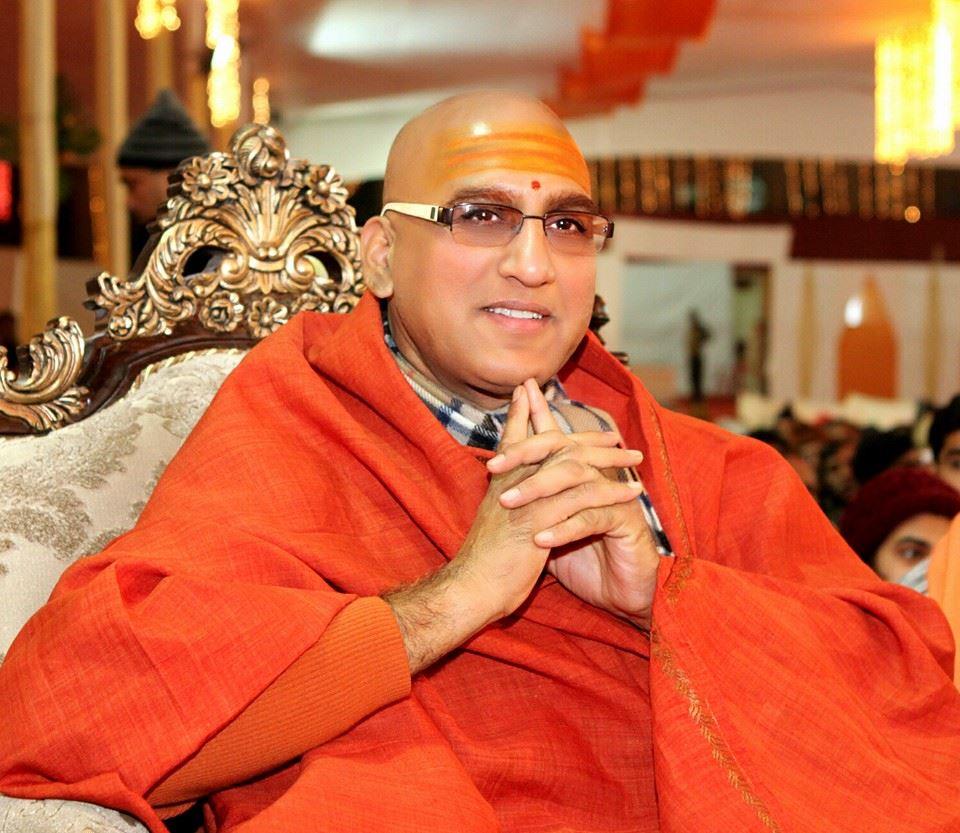
Swami Avdeshananda Giri is the Acharya Mahamandaleshwar of the largest monastic order of Juna Akhara, founded by Sri Adi Shankracharya. This status was awarded to him in 1998 at the Kumbha Mela in Haridwar. In India he is known as a yogi, scholar, authoritative commentator on classical sacred texts and preacher of Vedanta.
As the head of Akhara, Swami Avdeshananda Giri leads the Juna Akhara processions in the Kumbha Mela parades. Over the years as a spiritual leader, he has read tens of thousands of sermons, conducted thousands of sannyas initiations and various spiritual statuses.
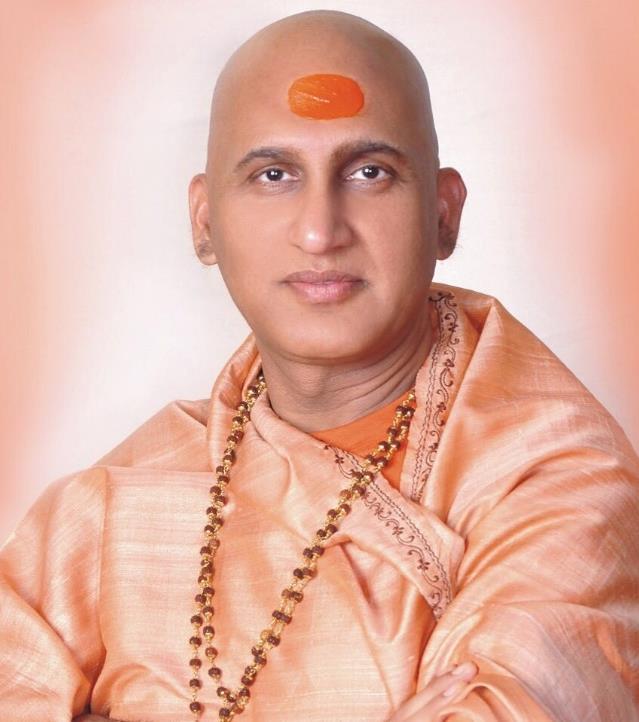
Initiated in the tradition of Naga Sadhu, now Swami Avdeshananda combines his practice with a wide range of social activities - from conducting and spiritual discourses to charitable projects in hospitals and actions to combat the shortage of fresh water. He is also a member of the world council of religious leaders and speaks at the UN on religious issues in modern society.
In 2010, in Haridwar, Guru Swami Vishnudevananda Giri and his disciples met with the acharya Juna Akhara Mahaprabhu Swami Avdeshananda Giri. In Ujjain, in 2016, the meeting of the acharya Swami Avdeshananda Giri with Mahamandaleshwaras from Mahayogi Pilot Babaji - Shraddha Mata, Chetan Mata and Swami Ananda Lila was held.
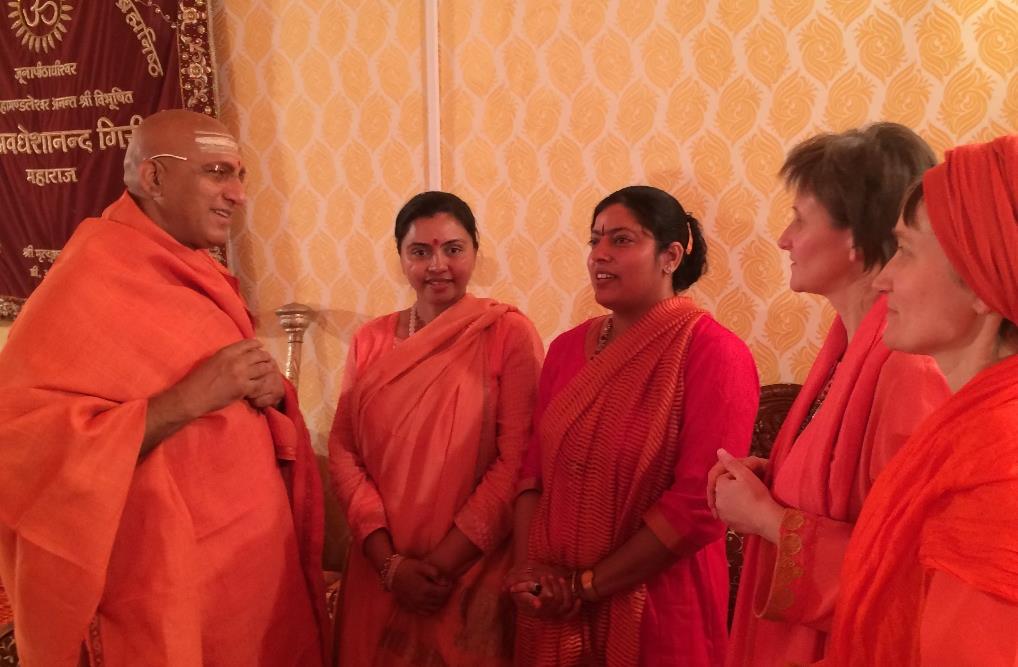
Yogmata Keiko Aikawa

Yogmata Keiko Aikawa was born on May 31, 1945 in Japan in the family of a lawyer and influential politician, one of the richest people in Japan. But her sincere desire to explore a person and an endless spiritual search once made her abandon worldly pleasures and become a seeker of an eternal spiritual treasure. As a disciple of Hari and Avatar Baba, through many practices and austerities, she attained full realization and enlightenment. Yogmata gained the mystical power to heal others and healed many suffering souls. She is a true master of body and mind restoration.
Yogmata says: “Truth cannot be expressed in words, but its presence can be felt. Truth envelops absolutely everything with its aroma ”. She further adds that "yoga and meditation is the science of transforming life, which allows a person to find inner peace and thus discover their inner potential and strength."
For the benefit of the whole world and humanity, Keiko Mata publicly entered samadhi 18 times while underground, including during the Kumba Mela spiritual festivals.
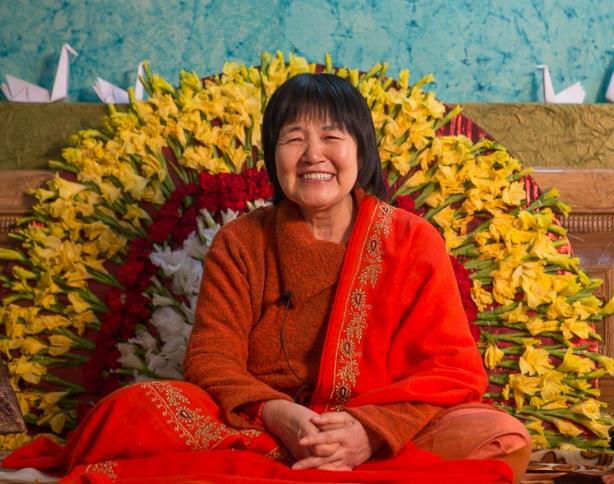
Chetana Mata

Chetana Mata met Babaji in Nanital when she was about 17 years old. Babaji was sitting on the porch of his ashram when he saw a girl walking along the road, and the saint was not so much attracted by her image as by the energy emanating from her. Baba started a conversation with her and offered to take sannyasa. The girl said that she would like to, but thinks that her parents will be against, even though they are devotees of Babaji. To which the saint said that she should bring her parents, and that he would talk to them.
The next day, her whole family came to the saint, with whom they had a fateful conversation for their daughter. Relatives said that they saw no point in their daughter taking sannyasa and practicing in the ashram. To which Babaji said that perhaps she will become a better practitioner than himself and will quickly achieve realization through a deep experience of samadhi. Hearing such words of the Master, the relatives gave their consent. Babaji immediately performed a yagya and initiated her into a sannyasi.
Then, after meeting with Pilot Babaji, Chetena Mata felt a strong connection with spiritual practice, left the world and began to practice. Now, despite her Mahamandaleshwar status, she lives most of the time in Babaji's ashram. Her life is service to her Guru.
Shraddha Mata
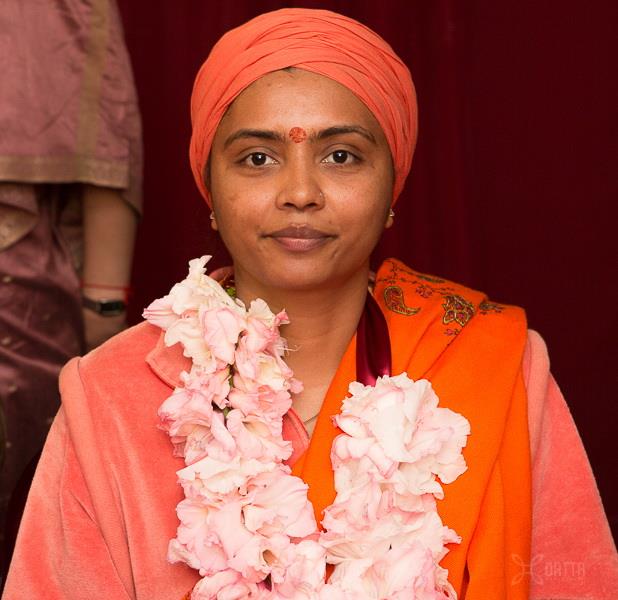
Back in the 70s. of the last century, Mahayogi Pilot Babaji practiced in the mountainous regions of the northern state of Sikkim. In those places, according to Babaji, there were saints and highly advanced sadhaks. Babaji himself retired there to practice meditation and samadhi, and he also often performed yagyas among his devotees. On one of these days, when Babaji was sitting surrounded by students, a girl in a football uniform approached him, she was about 11 years old.
This girl was followed by a whole football team. Babaji was very surprised, he asked: “What are you doing here? You shouldn't be here, ”and continuing to talk to her, he said that after graduating from college, after she received her diploma, let her come to him to practice. And so it happened. This girl, after graduating from college, came to Nanital to Babaji's ashram with three other friends. After some time Baba asked them what they would like to do in life.
One said that she wanted to get married, the other that she wanted to get a good job, and the girl whom Babaji met said she wanted to become a sannyasi. Babaji, seeing her spiritual aspiration, without delay, conducted a yagya and initiated her into a sannyasi, giving her a spiritual name - Shraddha Mata. Later, under the guidance of Babaji, she realized samadhi. Now Shraddha Mata has the status of Mahamandaleshwar Panch Dashanam Juna Akhara.
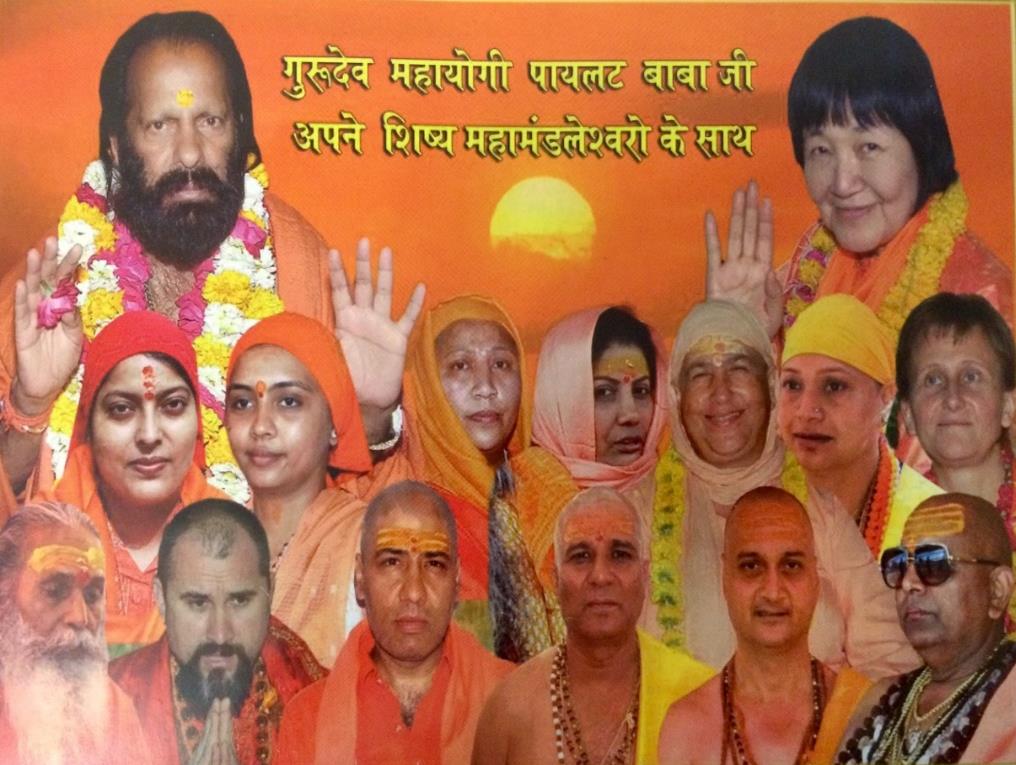
Mahamandaleshwaras of the ancient Indian monastic order of Juna Akhara

